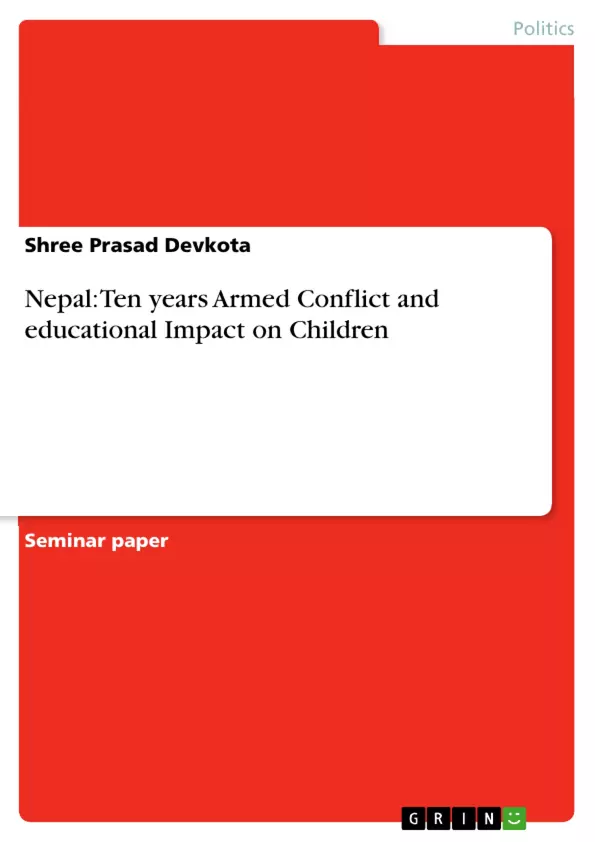The armed conflict started from the year since 1996 to 2006 against the Nepali state by the Maoist party in Nepal. No any Nepalese is free from the conflict and its effect, affected all aspects of livelihood and dominion (Pherali, 2006). The armed conflict in Nepal has left a legacy of some 15,000 dead (INSEC, 2007), and more than 1,300 missing (ICRC, April 2009).
According to Shrestha, (2004) he has acknowledged that the armed conflict also destroyed human life and physical infrastructures as well. Similarly, Pherali (2011)states that children from rural people to the urban, being abduct from their home, and killing of innocent children and people, people being homeless, people being internally and externally displaced, the big number of children being orphan and homeless were the regular phenomena in that period.
However, ten years armed conflict with the political aim has been the longest ever conflict witness in the past of Nepal. Ten years since then, the conflict has overcome almost 70 out of 75 districts, making it a problem of Nepal in many sectors like health, education etc .Therefore it can be said that Ten years conflict has a profound effect on children development negatively.
Inhaltsverzeichnis (Table of Contents)
- Introduction
- Armed conflict and Children Involvement
- Armed Conflict and Children Education
- Post Conflict Situation and Children Reintegration On Education
- Conclusions
- References
- Annex
Zielsetzung und Themenschwerpunkte (Objectives and Key Themes)
This research seminar paper aims to analyze the impact of the ten-year armed conflict in Nepal (1996-2006) on children's education. The paper examines how the conflict affected children's involvement in armed groups, their access to education, and the challenges faced in their reintegration into educational systems after the conflict ended.
- Children's involvement in armed conflict in Nepal
- The impact of the conflict on children's education
- The challenges of post-conflict educational reintegration
- The role of political and social factors in children's involvement in the conflict
- The long-term consequences of conflict on children's development
Zusammenfassung der Kapitel (Chapter Summaries)
Introduction: This section provides an overview of the ten-year armed conflict in Nepal, highlighting its impact on various aspects of life, including education. It emphasizes the widespread destruction and displacement caused by the conflict, particularly affecting children.
Armed conflict and Children Involvement: This chapter explores the historical context of children's involvement in armed conflict, referencing instances from ancient Greece to contemporary conflicts. It specifically examines the heavy use of children in the Nepali conflict, emphasizing the violation of children's rights and the factors that led to their recruitment into armed groups. The chapter explores both forced and voluntary recruitment, analyzing the underlying motivations and circumstances driving children's involvement.
Armed Conflict and Children Education: This section delves into the detrimental impact of the conflict on the education sector in Nepal. It describes the threats and intimidation faced by students and teachers from both the Maoist party and government security forces, highlighting the disruption of schooling and the erosion of educational infrastructure. The chapter also discusses the use of educational institutions as training centers and army camps by both conflicting parties, further underscoring the impact on children's access to education.
Schlüsselwörter (Keywords)
The primary focus of this research paper revolves around the impact of armed conflict on children's education in Nepal. Key terms and concepts include children's involvement in conflict, the disruption of educational systems, post-conflict reintegration, and the long-term consequences of conflict on children's development. The paper also examines the role of political and social factors in children's recruitment into armed groups and the challenges of rebuilding education systems in post-conflict settings.
- Quote paper
- Shree Prasad Devkota (Author), 2014, Nepal: Ten years Armed Conflict and educational Impact on Children, Munich, GRIN Verlag, https://www.grin.com/document/274904



